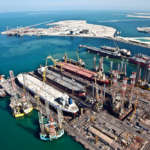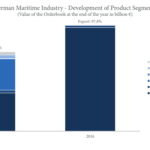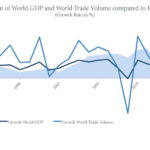German shipbuilders have managed to achieve positive results even in times of crisis. Their ability to offer advanced technology is the key
A sense of crisis prevails around the globe. The situation of the global shipbuilding industry reached a new low in[ds_preview] 2016, with orders received dropping to 11mill. Compensated Gross Tons (CGT). This is the lowest level of the past 20 years. New orders have barely increased during the first three quarters of 2017, climbing to a total of 13.5 mill. CGT.
The number of deliveries has again surpassed the number new orders by a wide margin of more than two to one, continuing the downward trend of the global order book since the peak experienced in 2008 to just 40% of that year’s level. The slight rise in new orders is mainly owed to an increased demand for tankers and cruise vessels.
Weak trade volume a challenge for shipping
Compared to the crisis year of 2016, incoming orders for tanker tonnage have more than tripled. At the same time, orders for bulk carriers, container ships and general cargo vessels recovered rather slowly during the first three quarters of the year 2017. In many segments, huge overcapacities continue to bear heavily on the shipping industry. Freight and charter rates remain at low levels, as do prices for second-hand tonnage. Since it peaked at 12.5% in 2010, global trade volume growth has slowed considerably. The International Monetary Fund has forecast a growth rate of no more than 4.2% for the year 2017. While growth is expected to continue, growth rates will be significantly lower than in previous decades. Apart from short-term cyclical factors, the »Fourth Industrial Revolution« will automate and innovate existing production methods in the medium and longer term, shortening transport routes and reducing transport volumes. Structural changes in the global energy markets will contribute to this development. New, energy-saving technologies entering all industry segments, and the increasing share of alternative energy sources in the energy mix will have an impact on the global demand for fossil fuels. A dropping demand for conventional energy sources is certain to cause structural changes in global sea transport. Because of its direct dependence on sea trade, the shipping industry is highly susceptible to factors inhibiting trade volume growth.
Cruise ship building dominant in Europe
Serving an entirely different market than cargo shipping, the cruise sector is booming. With a never-ending supply of new ideas for trips and on-board attractions, the cruise industry continues to draw holiday-makers, setting record after record. The demand from cruise tourists is exceeding the supply. According to the industry association CLIA, as many as 26 new cruise ships were expected to enter service during the year 2017 alone. Building cruise ships is complex and demanding. River, ocean and specialised cruise vessels must meet a wide range of capacity requirements. What is more, ships travelling to extreme reaches of the planet, from the tropics to polar regions, confront the shipbuilding industry with tough technical challenges. As innovative technologies, such as eco-friendly Liquefied Natural Gas (LNG) propulsion, make inroads into shipping, few yards are capable of satisfying the complex requirements of advanced cruise ship building. With their capacity fully utilised for years to come, orders for new vessels are facing a supply bottleneck. The European shipbuilding industry is a main beneficiary of this enormous demand from the cruise sector, a fact clearly reflected by current order figures. The European order book has been growing steadily since 2011. Thanks to the booming cruise industry, it reached a value of around 62.1 bn $ at the end of October 2017. By the same month, new orders worth 18.3 bn $ had been received by European yards, equivalent to roughly 40% of the global intake. Compared with Asian countries, the European orderbook is the only one showing growth, with new ship orders exceeding the number of newbuilds delivered. Meanwhile Chinese yards are still contending with the challenge of huge overcapacities and low profitability. In Japan, the previous year’s downward trend continues, as well, while the South Korean shipbuilding industry, following a catastrophic year 2016 and billions of dollars spent on restructuring, has recently reported a slight increase in new orders.
German shipbuilding stands its ground globally
According to reports by Clarksons Research, the number of active shipyards in the intenational newbuilding market has reduced by nearly two thirds since 2009 and many of the about 360 shipyards are currently completing their last vessel. These numbers document the current tough competitive environment in which German companies must maintain their position. German yards have turned away from standard ship types, instead focusing on passenger ships, ferries, yachts, all types of naval ships and other specialised vessels. This specialisation has enabled the German shipbuilding industry to adapt to a changed market environment and to weather the current market storm successfully.
Significant opportunities for innovative shipbuilding lie the intensifying global discussion of new means to reduce the environmental footprint of the shipping industry. Emissions of climate-damaging exhaust gases, other air pollutants caused by low-purity fuels, carriage of invasive species in ballast water by example have come under scrutiny. Tightening regulations require improved technologies. German marine equipment suppliers take a leading role in developing innovative green technologies and offering advanced solutions for challenging projects. Their comprehensive expertise has helped the German shipbuilding industry achieve positive results even in times of crisis; the German order book actually grew to an all-time high of 18.5 bn € in 2016. This success highlights the leading position of the German maritime sector and encourages the industry to drive product innovation and the development of leading-edge technologies.





















